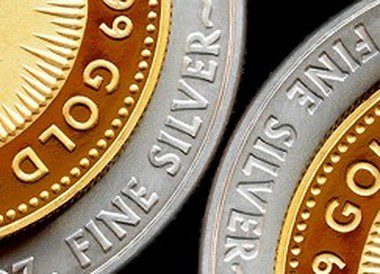What Drives the Price of Gold and Silver?
If there is a credible rumor that the Fed is planning to further extend its “Quantitative Easing”, how would you expect the monetary metals to react? Typically, the gold price would rise and the silver price would rise even more. The question is why.
Traders read the headlines and they know how the price “should” react to such news, and they begin buying. For a while, the prophecy fulfills itself. But then what happens next? It may take an hour or a month, but sooner or later some of the new buyers begin to sell. What can be bought on speculation using leverage must eventually be sold. Traders who buy gold and silver futures think of their “profits” measured in dollars. They cannot profit from the rising gold price until they sell. So, sooner or later, they must sell. Alternatively, if the price goes down, they must sell because they are incurring losses at a multiple of the price drop due to their use of leverage.
Nearly all buyers of futures are speculators. They could be called “naked longs” because they have neither the intent nor the means to take delivery. Their predictable behavior when a particular contract heads into expiry has a characteristic behavior. One can see this in the gold and silver bases.
One way to debunk the “naked short seller” conspiracy theory is to watch the basis heading into First Notice Day. Naked longs must sell the expiring contract, and if they wish to remain long the metal, they must buy another farther-out contract. Right now, for example, we are in the late stages of “rolling” from the March silver contract to May (there were about 80,000 contracts open a month ago, and now about 30K).
Anyway, getting back to the topic, speculators are frequently driving up the price by buying news and rumors and almost as often driving down the price. In the short run, they can have an enormous impact on the price. But in the long run, they have almost none.
There are an estimated seven billion people on Earth. Most of them don’t read about the US stock market, the press releases from the Governor of the Bank of England, or the latest politics surrounding the appointment of a new head at the Bank of Japan. They don’t know how the price is supposed to move when earnings estimates for the S&P 500 are raised or lowered.
They are doing one of two things with physical metal. They are either slowly hoarding it, as the only safe store of wealth they can understand. Or they are performing arbitrage, each with his notion of the “right price”. When metal is priced lower than their threshold, these latter folks buy. When the price rises above, they sell. Most of them, of course, don’t even look at the price measured in dollars. They are using another currency, such as rupees.
The actions of the hoarders will sooner enough cause the final descent into permanent gold backwardation. But don’t count your paper “profits” just yet. This is not a time when gold owners get “rich”. Sure, the gold will have a high value indeed, though it may be worth your life to show anyone that you have it as occurred throughout history.
Permanent gold backwardation—the withdrawal of the gold bid on the dollar—will lead to bad times. Certainly, government policies are causing the capital base that supports our society to be hollowed out. If it can no longer support us, if the debt-based currencies no longer work, and if industries such as food distribution seize up due to lack of credit, then even the best case is pretty bleak.
For now, the actions of the arbitragers drive the price. Gold and silver are totally unlike any other commodities. Both metals have a stocks to flows ratio that is extraordinarily high. Stocks to flows is total global inventories divided by annual mine production. For gold and silver, this number is in the many decades. For other commodities, it’s measured in months.
All of this inventory is potential supply at the right price. If the price rises above the threshold set by a large number of owners, then metal comes into the market. If the price falls below this threshold (or the threshold ratchets up) then metal is taken out of the market.
The speculators can drive the price quite far in either direction, in the short term. But it is the hoarders and arbitrageurs who drive the price in the long term. A century ago, gold was worth about $20 an ounce. Now it is worth about $1600. This is another way of saying that the dollar has gone down to 1/80th its value. This trend is not going to end soon (or indeed end at all). But it does not move in a straight line, as these past few years have proven once again.
Wouldn’t it be nice to have an indicator that can help one determine whether hoarders and arbitrageurs are driving the price at the moment, or if it’s just the speculators again? This is precisely what the basis shows (among other things).
In other words, are you buying your physical gold or silver into a speculative move (bad), or are your purchases part of a fundamentals-driven move (good)?
Monetary Metals is now publishing graphs of the basis for gold and silver along with our commentary. Click here to view the Last Contango Basis Report (free registration required).






Keith,
I find it amazing to be able to learn about gold,futures,inflation vs deflation.
You do not believe in mass naked shorters.
This is quite possible,but what do you think about big banks those fees when purchasing or selling PM for customers, charges for storage PM and perhaps this PM use to arbitrage.
Called bulls in bear skin.
Do you think this fraud existence and what are the consequences?
Nico: can you restate the question, I could not quite follow? Thanks.
Keith, it looks to me like Nico is wondering if bullion banks fraudulently use metal for trading that they are storing for customers.
I found your article very informative. I appreciate your scientific and unemotional approach. Thanks!
Thanks Samiam, this is what I meant.
As an example, what happend to mf global.
(excuse me for my bad english language use)
Only the bullion banks themselves know exactly what they are doing.
That said, account agreements for a margin account typically allow the financial institution to hold your assets as collateral against your position and to further allow them to pledge those assets to their counterparties as collateral (this was true for MF Global).
What positions they put on is, of course, the big question. I would expect that a bullion bank would typically be hedged. If they take your gold and lease it, then they give up the physical metal and get a lease in exchange. If they sell it, they would buy a future at the same time. They would not want to take price exposure, certainly not on the short side.
By the way, I am not saying that this is necessarily good for the client. The above has plenty of counterparty risk. It is not necessarily fraud, but it can lead to client losses.
the larger question is how such behavior, worse yet, when mf global corzined the metal, affects the basis. i’ve been tinkering with the basis/cobasis sice fekete time. fekete never addressed the possibility metal could be corzined, silverax thinks only nutjobs would suggest that every ounce of metal would not be in those etf’s. i use overlays and spreadsheet to examine the basis and nothing showed in my data that mf global was going to default. not prior and not after did i see any stress in my data – which may not mean much but i dont know of anybody else who reported sudden move in the basis to predict metal vaporization. so i leave this with you to tell me where i went wrong – possibly by showing your data around mf global.
the larger question is how such behavior, worse yet, when mf global corzined the metal, affects the basis. i’ve been tinkering with the basis/cobasis sice fekete time. fekete never addressed the possibility metal could be corzined, silverax thinks only nutjobs would suggest that every ounce of metal would not be in those etf’s; and all being above board. i use overlays and spreadsheet to examine the basis and nothing showed in my data that mf global was going to default. not prior and not after did i see any stress in my data – which may not mean much but i dont know of anybody else who reported sudden move in the basis to predict metal vaporization. so i leave this with you to tell me where i went wrong – possibly by showing your data around mf global.
ex nihilo: For a week or two prior to the MFG BK, the bases in gold were rising and cobases falling even more sharply.
If people expected the BK with enough advance warning, they could have moved bars they owned outright to another custodian or out of the system. Those few who held futures with intent to take delivery (and cash) could have sold them and bought the gold in the cash market. *THAT* would have caused a change in the basis, if there were enough of them.
thanks keith. my frustration over the past many years, tweaking the basis calcs, trying to incorporate gofo rates and other fudge factors, the basis doesnt tell me anything about the stress in phyzz. at least not that i can see. my theory, as you know from past comments, is that the metal is loaned out many times over w/o full disclosure, phyzz inventories are misreported and even the basis is rigged via gofo rates. i did not believe it but after libor rigging, i do.. if your basis calcs talked to you when mfg went down and you profited from that insight, good for you.